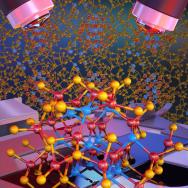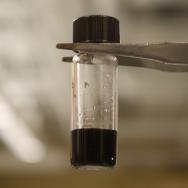Changing the chemistry of a compound is difficult by itself, but modifying materials only a few atoms thick is its own challenge.
A group of University of Chicago scientists announced an innovative method to tailor the surface groups of a class of compounds known as MXenes. Surface groups are the elements or compounds on the surface of a material. When scientists change these groups, the material displays different properties and can be used for applications such as building better batteries and new superconductors
“When it comes to ceramic materials like titanium carbide, it is hard to modify its properties once it is created,” said graduate student Vlad Kamysbayev, the lead author of the study, which was published on August 21 in Science. “Prior to this study, there were no experimental methods to precisely manipulate surface groups’ chemistry for two-dimensional materials.” However, when Kamysbayev and his colleagues employed a new strategy to install and remove surface groups, the resulting MXenes showed distinctive structural and electronic properties.
Materials that are two-dimensional, like titanium carbide MXene, can make taking measurements difficult and require special instruments for scientists to understand what is happening at the atomic level. “The most difficult thing about working with two-dimensional materials that are just several atoms thick is observation,” said Prof. Dmitri Talapin, an expert in inorganic nanostructures. “It can be challenging to understand what is exactly happening, but with an arsenal of methods complementing one another, you can start to get a picture.”
The researchers worked to see if they could successfully modify outer layers of a titanium or niobium metal without disrupting the atomic structure structure of MXenes. They wanted to see if surface groups could be replaced or eliminated altogether, through the use of molten inorganic salts as high-temperature solvents. These surface groups could include atoms ranging from nitrogen to tellurium. Still, there were two unknowns: whether they could create an experimental method to modify these groups, and if the same method could be used for multiple different types of surface groups.
The new materials they created showcased several key findings. One was that it was possible to add, subtract, or replace surface groups and that a universal approach could be used for a variety of surface groups. All of this was accomplished without changing the internal structure. “This is an unprecedented event,” Kamysbayev said.
The resulting materials showed unique property changes when the surface groups were modified. For instance, titanium carbide is a very hard and brittle ceramic. However, after installing tellurium surface groups, the two-dimensional sheets of titanium carbide stretched by 18%, almost like a rubber band. Several of these new MXenes upon cooling behaved as superconductors. The plethora of new redox-active surface groups open the possibility to build faster and more powerful batteries and supercapacitors.
“We introduced a pretty general chemical approach that applies to a broad class of materials, so using this method it should be possible to create a couple of hundred new functional materials, maybe more. In this work alone we demonstrated twenty new materials,” said Talapin.
The researchers used unique research facilities at the Advanced Photon Source and at the Center for Nanoscale Materials at Argonne National Laboratory. The publication is a result of an ongoing collaboration between the Talapin group and the lab of Robert F. Klie at the University of Illinois at Chicago.
Citation: “Covalent surface modifications and superconductivity of two-dimensional metal carbide MXenes.” Kamysbayev et al., Science, Aug. 21, 2020. DOI: 10.1126/science.aba8311
Funding: Department of Defense, National Science Foundation, U.S. Department of Energy

